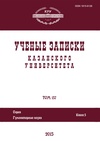«Маньчжуро-монгольский словарь» (1717) как источник «Монгольско-русско-французского словаря» О.М. Ковалевского (1844)
“The Mirror of Manchu-Mongolian Literature” (1717) as a Source of O.M. Kovalevsky’s Mongolian-Russian-French Dictionary (1844)
Author(s): Enkhbatyn MunkhtsetsegSubject(s): Language studies, Lexis, Semantics
Published by: Казанский (Приволжский) федеральный университет
Keywords: Manchu-Mongolian dictionary; dictionary; Mongolian-Russian-French dictionary by O.M. Kovalevsky; word; interpretation; meaning;
Summary/Abstract: This paper examines the facts related to the use of material from the bilingual explanatory thematic dictionary “The Mirror of Manchu-Mongolian Literature Published by the Highest Order” published in 1717 in Beijing (hereinafter – HAMM) in the Mongolian-Russian-French Dictionary compiled by O.M. Kovalevsky (Józef Kowalewski) and published in the middle of the 19th century (hereinafter – the MRF). The HAMM dictionary is listed among the sources of the MRF, and many words have corresponding references to the book and folio of this dictionary. In this study, the vocabulary records of these two dictionaries were compared to identify changes reflected subsequently in the MRF dictionary. The paper provides a number of examples showing that most changes concern the grammatical forms of verbs (some were modified, deleted, or added). The choice of verb forms for the MRF dictionary was influenced by two factors: their use in the Mongolian language of that period and the difference in the way of expressing some meanings in the Manchu and Mongolian languages. The HAMM dictionary is an explanatory one, and it is the only dictionary where a parallel translation into the Mongolian language is presented not only for the Manchu words, but for all their interpretations, sometimes numbered up to five. All of them were widely used by O.M. Kovalevsky both for the exact translations into Russian and for the adding and as the result increasing of the headwords. In the paper, this statement is confirmed by numerous examples. The main conclusion of this work is that when compiling his dictionary O.M. Kovalevsky widely used material from the HAMM dictionary. First of all that were the head words, but also their interpretations (basic, additional, and Mongolian interline inserts) which helped for both Russian and French translations, and for expanding the number of headwords.
Journal: Ученые записки Казанского университета. Серия Гуманитарные науки
- Issue Year: 160/2018
- Issue No: 6
- Page Range: 1321-1333
- Page Count: 13
- Language: Russian

